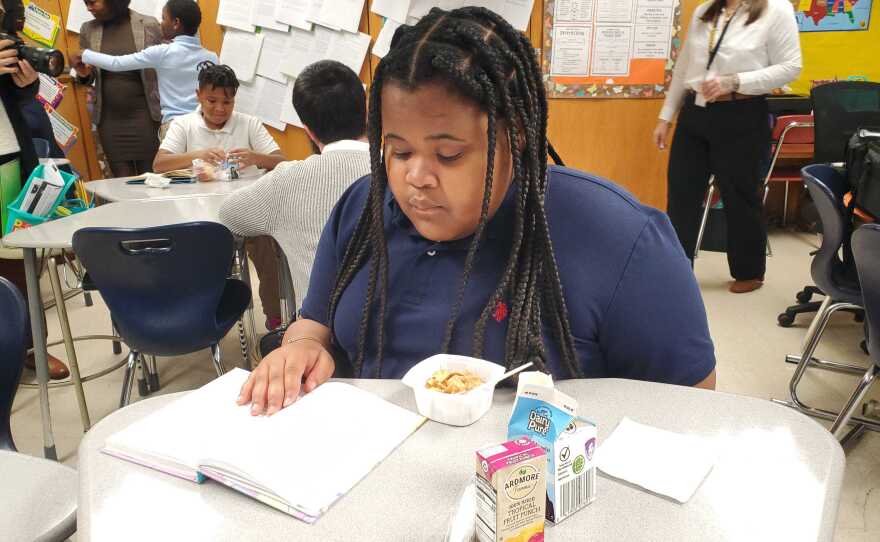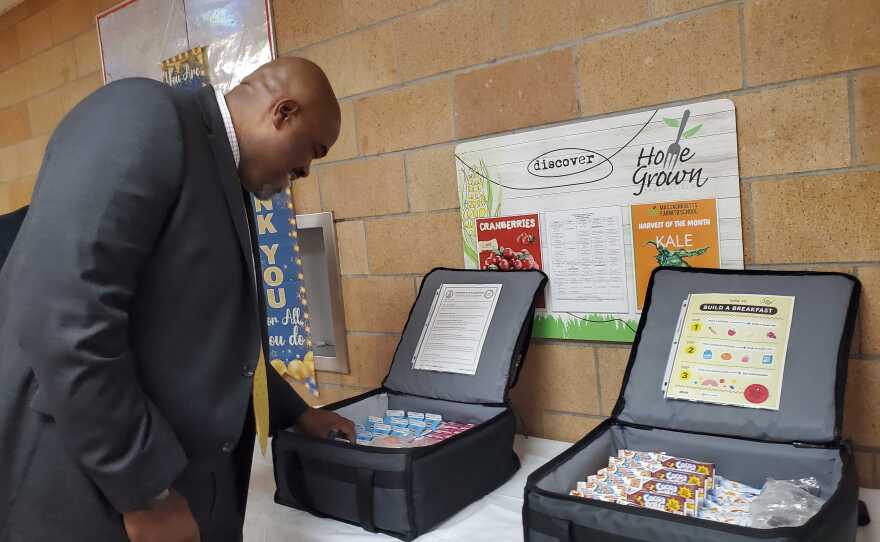Springfield fifth grader Kennedy Kerr was enjoying her cereal and reading a chapter book when suddenly a dozen adults entered her classroom at Rebecca M. Johnson Elementary School to observe her and her classmates having breakfast. Her first visitor — Massachusetts Secretary of Education Patrick Tutwiler.
He asked her what she was eating and reading and how she liked having her breakfast right at her desk.
"It makes me manage better," she said, of having breakfast as she starts her school day. "It makes me focus better."
Kennedy is just one of thousands of Springfield students who are getting access to breakfast every school day as part of the "Breakfast in the Classroom" initiative — a model that has breakfast brought to students in their classroom setting, instead of them going to a large cafeteria to eat.
Tutwiler toured the facility with Andrea Silbert, president of the Eos Foundation, which has partnered with Springfield for over a decade on this initiative. The foundation offers grants to fight hunger in Massachusetts.
Springfield Public Schools — A model to be replicated
Silbert said the idea of offering breakfast in the classroom came from a visit to a Colorado school district 14 years ago where they found out any student who qualifies for free lunch, due to federal guidelines on poverty, is also eligible for a free breakfast. However, many of them don't eat, she said.
A recent study found only 37% of Massachusetts students in high-poverty districts take advantage of free breakfast if it's served in a cafeteria, despite the fact it is open to all.
While the program is seeing traction in other communities in the state including 73.7% in neighboring Holyoke and 75% in North Adams, no community in the state has reached the near total participation rate that Springfield has. The city offers the program to every student in every grade going up to high school.
"There's no city in the state and in the country, that is serving 87% of its kids breakfast every day," she said.
Tutwiler said Springfield is a model to be replicated.
"I really see this as being potentially a national model for making sure that kids have breakfast opportunities to access breakfast in the classroom," he said. "We see this as being a critical piece of producing strong academic outcomes. Students need to be food secure. They need to have the opportunity to have access to nutritious meals and we're seeing that right here."
Fifth grade teacher Rochelle Maynard-Gonzalez said the impact on the students is significant.
"Making sure that they eat first thing in the morning...to have the opportunity to do it, it's great," she said, adding that it gives her an opportunity to spot any problem areas. "If there are any kids that have any problems at home, or they come in and they're in the mood. That gives me time to be like, 'hey, you want to step out? You want to talk about it, you need a hug?'
Maynard-Gonzalez said those 15 to 20 minutes in the morning sets the tone for the rest of the day.
"Every day they come in, it's something new. So, it's like you're meeting them for the first time, you know, when they come in," she said.
"Everyone is invested"
Lidya Rodriguez is the director of operations and communications for Home Grown Springfield, the district's food service provider. She said each student is required to take a minimum of three items including a fruit or fruit juice. She said the initiative is about more than providing a balanced breakfast.
"They get to sit down and have a meal with their peers, with their teacher and really build that community first thing in the morning," she said.
The Eos Foundation is looking to expand the program across the state. Silbert said the foundation is able to fund the equipment necessary to get the breakfast items to the students, mainly refrigerated bags that contain all the items, and then the federal government reimburses schools for the food. It can be challenging to get school districts to change their current methods of delivering food to students.
"In other schools, people are very reticent. Teachers are nervous. Principals are nervous to let them bring the food into the classroom," she said, adding that they have offered opportunities for districts to come to Springfield and see the inititave in action. "So people can see it really isn't particularly messy. The kids take the trash and put it outside."
Superintendent of Schools Sonia Dinnall said the program works because everyone is invested.
"Buy-in is easy when we see the impact this has on our students and how we see learning and attendance being positively impacted by having breakfast in the classroom," she said.
The Eos Foundation has launched a three-year statewide initiative to implement the program, using Springfield as a model, in district's across the state.











![Massachusetts Secretary of Education Patrick Tutwiler [left] speaks with Lydia Rodriguez [right], director of operations for HomeGrown Springfield, the food service provider for the district. The "Breakfast in the Classroom" model succeeds in Springfield where 87% of students are eating in the morning.](https://npr.brightspotcdn.com/dims4/default/e3f38d2/2147483647/strip/true/crop/4032x2483+0+270/resize/880x542!/quality/90/?url=http%3A%2F%2Fnpr-brightspot.s3.amazonaws.com%2F7a%2F42%2Fc3241f294f4aba5c24d14bfe8d08%2F20251110-082805.jpg)
![Springfield Superintendent of Schools Sonia Dinnall [left] walks with Massachusetts Secretary of Education Patrick Tutwiler [right] during a visit to Rebecca M. Johnson School elementary school in Springfield. The "Breakfast in the Classroom" model succeeds in Springfield where 87% of students are eating in the morning.](https://npr.brightspotcdn.com/dims4/default/7405797/2147483647/strip/true/crop/4032x2483+0+270/resize/880x542!/quality/90/?url=http%3A%2F%2Fnpr-brightspot.s3.amazonaws.com%2Fff%2F09%2Fb74b1f4d44689e6863b765607eeb%2F20251110-083512.jpg)
![Springfield Superintendent of Schools Sonia Dinnall [left] speaks with Massachusetts Secretary of Education Patrick Tutwiler [right] during a visit to Rebecca M. Johnson elementary school in Springfield. The "Breakfast in the Classroom" model succeeds in Springfield where 87% of students are eating in the morning.](https://npr.brightspotcdn.com/dims4/default/1bc6d54/2147483647/strip/true/crop/4032x2483+0+270/resize/880x542!/quality/90/?url=http%3A%2F%2Fnpr-brightspot.s3.amazonaws.com%2F3e%2F60%2F0b4597e64565ba4cced3b9c684ce%2F20251110-082238.jpg)
